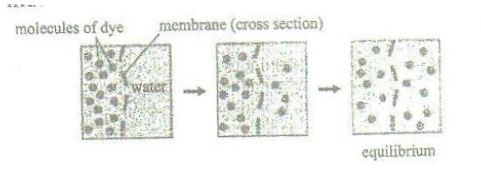The set up below illustrate a certain physiological process.

(a) (i) Name the physiological process
(ii) Give two examples of the process named in (a) (i) above in plants.
(b) State two ways by which the movement of dye molecules in the set up would be slowed down.
Answer:
(a) (i)
- Diffusion
(ii)
- Translocation of soluble products of photosynthesis from the leaves to the rest of the plant.
- Exchange of gases i.e #CO_2# and #O_2#
- Absorption of mineral salts by the root hair
cells when concentrated of ions is higher in the soil.
b)- Lowering the temperatures of the medium lowers theenergy content in each particle
- Lowering concentration gradient by adding water.
- Use of thick membrane or walls to increase diffusion distance.
- Diffusion
(ii)
- Translocation of soluble products of photosynthesis from the leaves to the rest of the plant.
- Exchange of gases i.e #CO_2# and #O_2#
- Absorption of mineral salts by the root hair
cells when concentrated of ions is higher in the soil.
b)- Lowering the temperatures of the medium lowers theenergy content in each particle
- Lowering concentration gradient by adding water.
- Use of thick membrane or walls to increase diffusion distance.
Share To Friends Via:



 Explain what would happen to red blood cells if they are placed in a concentrated salt solution.
Explain what would happen to red blood cells if they are placed in a concentrated salt solution.